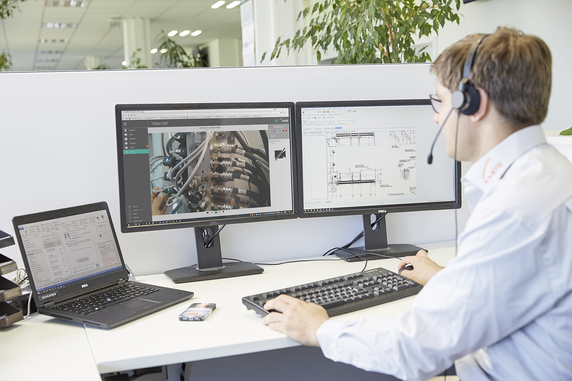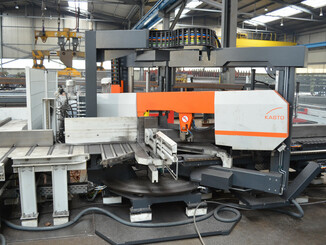
In order to meet the increasingly complex and individual wishes of customers and at the same time withstand the high cost pressure and international competition, new solutions and approaches are required in the steel trade. Digitalization offers the right answers: It makes it possible to intelligently network the entire material flow in steel trading companies and to make it more efficient in the long term.
The classic steel trade is undergoing change: the former link between steel mills and processing companies, whose sole task was to supply a manageable variety of materials in large quantities, is increasingly becoming a service provider and manufacturing partner.
Customer requirements are becoming higher and more individual, position sizes are decreasing, while the volume of orders is growing rapidly. Shorter and shorter delivery times are the standard, delays and quality defects are hardly tolerated. Steel traders have to take over more and more processing steps for their customers – and at the same time are under high margin and cost pressure in order to be able to compete internationally.
Many companies are therefore looking for new ways and solutions with which they can position themselves for the future under these difficult conditions.
Data acquisition and analysis is the basis
One promising strategy for this is digitization. Technologies and concepts from Industry 4.0 also offer enormous potential for the steel trade: from the ordering of raw materials to the dispatch of the fully picked order to the customer, all value-added processes can now be networked, uniformly controlled and intelligently optimised without paper. The basis for this is a detailed recording and in-depth analysis of all relevant data in order to identify and exploit potential. The aim is to make the entire material flow faster, more flexible, more resource-efficient and more cost-efficient.
Smooth communication is particularly important in the digital networking of the various processes and machines. This is made possible by suitable interfaces, for example between a higher-level ERP system such as SAP, Infor or Microsoft Dynamics and the control systems of individual plants. One example of this is storage: many steel traders are already using fully automated long goods warehouses, which score points for high storage density, fast access times and maximum inventory transparency, among other things.
These are controlled and managed by a Warehouse Management System (WMS). The software optimizes the processes in and around the warehouse, making intralogistics faster, more reliable and more efficient. A seamless connection to the respective host system ensures a uniform communication structure that significantly increases transparency and efficiency.

Fully exploiting the potential of intralogistics
The WMS offers users numerous functions such as the management of orders, batches, remnants and gates, a permanent inventory as well as the possibility to flexibly apply different in-out strategies and picking principles. Extensive statistics and analysis tools monitor both the utilization of the entire system as well as that of individual components.
In this way, the potential of intralogistics can be fully exploited: superfluous routes or unnecessary waiting times are avoided, possible changes can be simulated in advance and tried out without risk. The storage, sawing and handling technology specialist Kasto, for example, has developed the WMS Kastologic for its systems, which is specially designed for the requirements of long goods and sheet metal storage.
With Kastologic, users can uniformly control and monitor not only the processes in the warehouse itself, but also upstream and downstream logistics and processing steps. Even manually operated storage areas can be integrated into the system using the Kastologic mobile app.
The application enables the user to transmit all processes such as stock placements and transfers, picking, shipping and inventory information to the WMS via smartphone or tablet. Transparency and traceability are thus just as high as in automatic software-controlled warehouses.
A so-called “pick-by-crane” system can also be implemented effortlessly with Kastologic mobile: In this case, the user orders a connected indoor crane with the app, which independently positions the desired storage and retrieval processes using the corresponding coordinates and controlled by pushbuttons.
Digital sawing technology reduces waste
Sawing technology plays a central role in the ever-increasing processing spectrum in the steel trade. To serve the needs of their customers, most steel distributors have various machines in their portfolio that can perform both straight and miter cuts, with a variety of different materials and dimensions.
Here, too, digitalization offers great potential for increasing efficiency. Kasto, for example, has developed the Kastooptisaw software for its sawing machines. Taking into account various machine parameters such as kerf width and minimum residual piece length, this ensures optimum allocation of the stored long material and the sawing machine to the respective sawing orders. This is because operators often store bars, tubes and profiles of different lengths with different mitre angles due to past orders of one and the same material. Thanks to Kastooptisaw, these can be used with as little waste as possible – this reduces costs and saves space in the warehouse, as the material is used to the best possible extent and fewer offcuts have to be returned to storage.
In order to automate the material flow in the steel trade and thus make it particularly economical, sawing machines with manipulators and conveyor technology can also be seamlessly connected to automatic storage systems and supplied with the required materials via these.
The sawing process itself also runs autonomously if the machine is suitably equipped. This results in highly integrated systems that are seamlessly integrated into a continuous supply chain. Kasto has special expertise in the realization of such combined storage-sawing systems – and with the robot connection Kastosort, it also has a solution in its portfolio that can be used to automate upstream and downstream manufacturing processes.
Industrial robots can, for example, independently remove, deburr and chamfer, center and thread, mark and print, weigh, sort, stack and pick the saw cuttings. The robot control is combined with the saw control, the WMS or the existing ERP system, depending on the customer’s requirements. The user can thus also control and monitor this work step via a central interface and benefits from an optimally coordinated process chain.

Remote maintenance via smart glasses
Digitalization also enables helpful tools for maintenance and servicing. Kasto, for example, has developed the VisualAssistance assistance system for its machines and systems. This uses the concept of augmented reality to simplify remote maintenance. At its heart is an interactive app for tablets, smartphones or smart glasses. Customers can use it to connect with service staff via video and audio stream.
Users and technicians share the same field of view in real time. This facilitates mutual understanding immensely and helps to quickly identify individual system components and possible faults.
The Kasto experts also have the option via the app to provide visual assistance and, for example, to fade in markers in the live video. While the customer is performing maintenance or repairs on the saw or bearing on site, all the necessary information is shown directly on his display.
If he uses the smart glasses, he also has his hands free – which makes the work even easier. The service technicians of Kasto are virtually on site and guide the employees accordingly. Time-consuming training courses or expensive journeys are thus often superfluous.
Well equipped for future tasks
The steel trade cannot avoid digitalization and networking. The advantages that the new technologies bring with them are too great: more flexibility, in order to be able to react to individual customer wishes and fluctuating order volumes; higher performance, in order to remain reliably able to deliver even during workload peaks; material and cost efficiency, in order to make one’s own operation economical and competitive; and ergonomic, in order to relieve employees and avoid errors and accidents. All this helps steel trading companies to position themselves optimally for current and future challenges.
Facts & Figures
The Kasto Group, based in Achern, Baden (Kasto Maschinenbau GmbH & Co. KG), specializes in sawing, storage and automation technology for long metal products and sheet metal. The company is the global market and technology leader for metal sawing machines, semi-automatic and automatic long product and sheet metal storage systems, automatic handling equipment for metal bars, sheets and blanks as well as the corresponding software. With more than 175 years of experience, Kasto is one of the oldest family-owned companies in Europe. 170 patents, more than 140,000 sawing machines delivered all over the world and more than 2,200 installed automatic bearings testify to the company’s success. In addition to a branch plant in Schalkau, Thuringia, Kasto has subsidiaries in England, France, Singapore, China, Switzerland and the USA as well as sales and service partners in many other countries.
Web:
www.kasto.com



